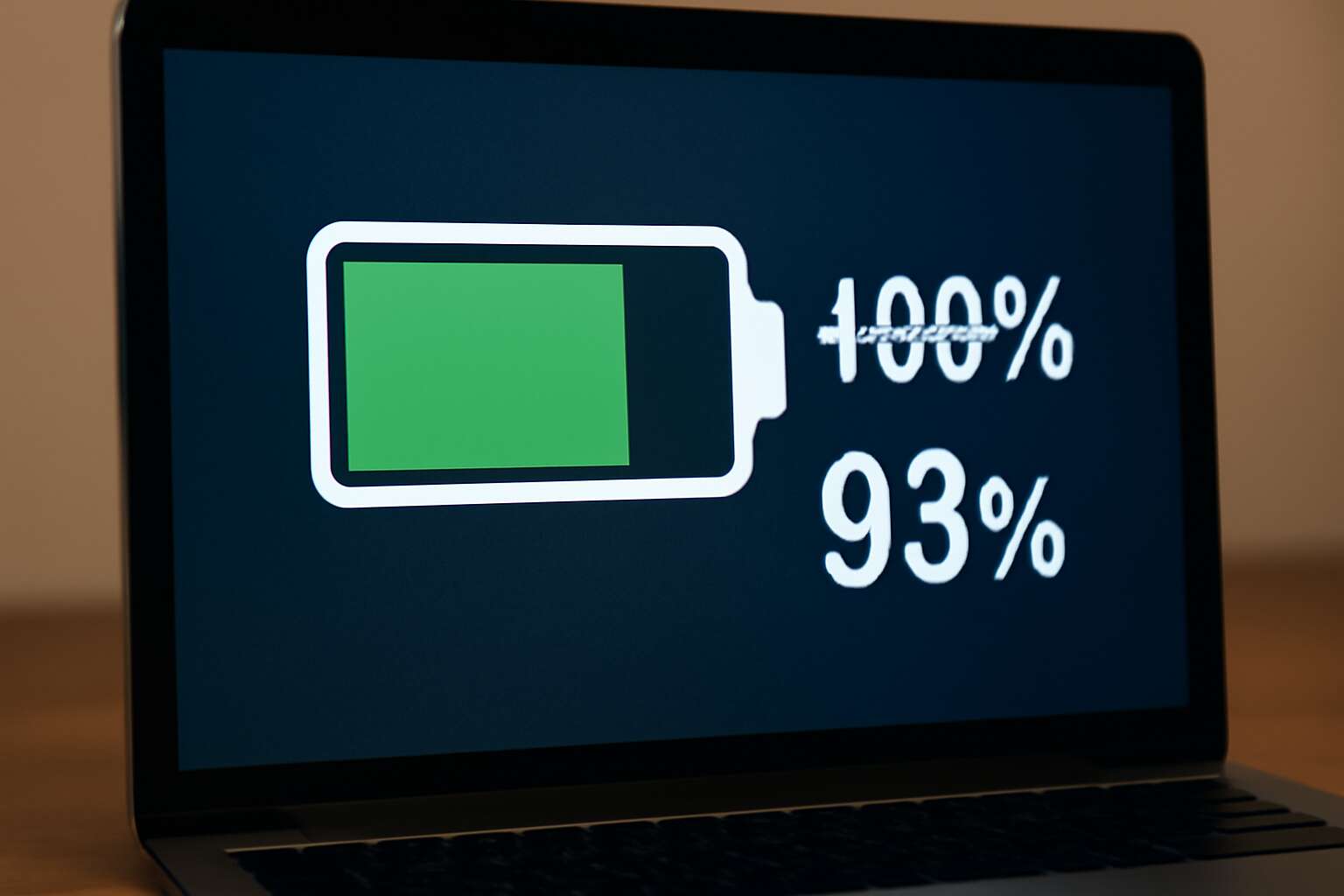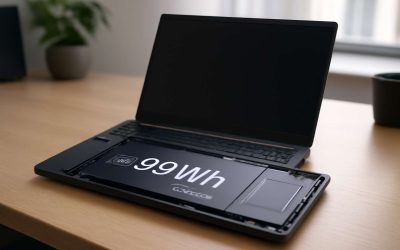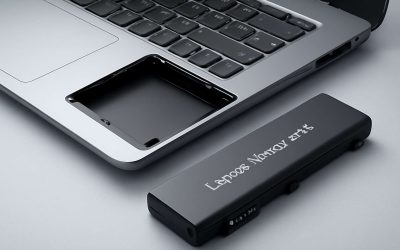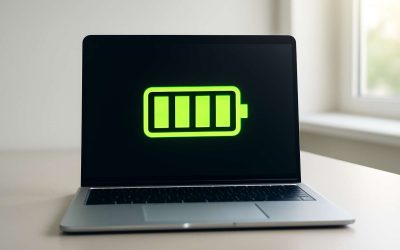Understanding Laptop Battery Percentage Fluctuations
Common Causes of Battery Percentage Jumps – Array
In the quiet moments of working on our laptops, few things seem as perplexing as the sudden drop in battery percentage. One moment, your device reads a perfect 100%, and the next, it’s at 93%, almost as if the battery is whispering secrets only it understands. This phenomenon—laptop battery jumps from 100 to 93—may appear trivial, but it hints at deeper, underlying mechanisms at play.
Understanding the common causes of battery percentage jumps requires a keen eye for the subtle interplay between hardware and software. Fluctuations like these often stem from calibration issues, where the battery’s internal sensors send inconsistent signals. Additionally, background processes or software misreads can temporarily skew the reading, making it seem as though the battery is draining in abrupt steps. Sometimes, rapid temperature changes or power management settings influence how the battery reports its status, leading to these inexplicable jumps.
To truly grasp the complexity behind these fluctuations, consider how the following factors might contribute:
- Sensor inaccuracies due to calibration drift
- Background applications consuming power intermittently
- Power management settings affecting charge reporting
- Thermal effects on battery chemistry
Why Batteries Show Sudden Drops from 100% to 93% – Array
In the silent symphony of our digital lives, a sudden drop in battery percentage can feel like a discordant note. When your laptop battery jumps from 100 to 93, it’s as if the device reveals a secret, teasing us with glimpses of hidden processes beneath its sleek surface. These fluctuations, subtle yet perplexing, underscore the delicate dance between hardware precision and software interpretation—a ballet often performed out of sight.
At the heart of these enigmatic shifts lie intricate mechanisms that often defy immediate understanding. Fluctuations like these may be caused by sensor inaccuracies, where the internal sensors tasked with measuring charge become misaligned or suffer calibration drift. Sometimes, background applications flicker to life, consuming power in ephemeral bursts, thereby distorting the battery’s apparent status. Thermal effects—those fleeting changes in temperature—can also influence how the battery chemistry behaves, further muddling the reading.
Understanding why a laptop battery jumps from 100 to 93 involves recognising that these are not mere numbers but signals, whispers from the device’s unseen ecosystem. The interplay of calibration, power management settings, and thermal dynamics weave a complex tapestry that often leaves users both bewildered and fascinated. In this delicate balance, each percentage point tells a story—one of precision, chaos, and the relentless march of technology’s silent heartbeat.
Diagnosing Battery Percentage Drops
Tools and Software for Battery Diagnostics – Array
In the labyrinth of modern technology, the phenomenon where a laptop battery jumps from 100 to 93 can feel like an inexplicable whisper from the machine itself—an unsettling reminder that even the most sophisticated devices possess their own cryptic language. Diagnosing these sudden fluctuations demands more than a cursory glance; it calls for a nuanced understanding of the underlying health of your battery. Hidden within the circuitry are clues that can reveal whether your device is signalling a deeper issue or merely misreporting its status.
Tools and software designed for battery diagnostics serve as vital explorers in this internal landscape. These programmes can scrutinise the battery’s capacity, monitor real-time performance, and identify anomalies that cause such jumps. For instance, some diagnostic tools offer detailed reports on voltage irregularities or temperature fluctuations, both of which could precipitate the sudden dip from 100 to 93. By leveraging these tools, users can gain a clearer picture of whether their battery’s behaviour stems from calibration errors or genuine degradation.
For those seeking clarity, a systematic approach often involves examining the following:
- Battery health reports generated by specialised software.
- Calibration tests to verify the accuracy of the battery percentage reading.
- Monitoring tools that track voltage and temperature trends over time.
Understanding the complex dance between software readings and physical battery conditions can illuminate why your laptop battery jumps from 100 to 93—an act that might seem trivial but hints at deeper truths about device health and longevity.
Steps to Identify the Cause of Sudden Drop – Array
Understanding why your laptop battery jumps from 100 to 93% can be a puzzle. The first step is to verify whether the drop is genuine or just a misreporting glitch. Diagnostic tools can help by providing detailed battery health reports, revealing discrepancies in voltage or capacity readings. This process often involves systematic checks to pinpoint the cause.
To identify the root of the sudden drop, follow these key steps:
- Run specialised battery calibration tests to ensure the percentage readings are accurate.
- Monitor real-time voltage and temperature trends with dedicated software to detect irregular patterns.
- Compare the battery health report against manufacturer specifications to spot early signs of degradation.
Sometimes, the jump from 100 to 93% may be caused by calibration errors, but persistent fluctuations could signal deeper issues. Recognising these signs early helps prevent unexpected shutdowns and prolongs your device’s lifespan. Being vigilant about these diagnostic steps is essential for maintaining optimal performance and clarity about the true health of your laptop battery.
How to Fix Battery Percentage Jumps
Battery Calibration Techniques – Array
In the realm of digital enchantment, a sudden **laptop battery jumps from 100 to 93** can feel like a glitch in the fabric of reality. These abrupt shifts often stem from misaligned battery sensors or calibration issues that obscure the true state of your power reserve. To restore harmony, a meticulous process known as battery calibration becomes essential, acting as a bridge between perception and reality.
Battery calibration techniques serve as the artisan’s tool to revive accuracy. The process involves fully charging your laptop to 100%, then letting it drain completely until it powers off on its own. After a recharge, the battery’s internal memory resets, aligning the software’s reading with the actual charge capacity. This simple yet effective ritual often reveals that the **laptop battery jumps from 100 to 93** was merely a spectral illusion, a misjudged reading rather than a real decline.
- Begin with a full charge, ensuring the battery is truly topped up to 100%.
- Use your laptop normally until it discharges completely and shuts down.
- Connect the charger and allow a full recharge without interruption.
- Repeat the cycle once or twice to optimise calibration accuracy.
By embracing this technique, users often find their battery percentage stabilising, shedding the ghostly fluctuations—like the unwelcome **laptop battery jumps from 100 to 93**—to reveal a more truthful portrait of power. This ritual not only enhances the longevity of your battery but also preserves its mystical integrity, ensuring your device remains a steadfast companion in your digital odyssey.
Optimizing Power Settings – Array
In the labyrinth of digital reliability, subtle adjustments to your power management can wield profound influence over perceived battery health. When the **laptop battery jumps from 100 to 93**, it signals a discord between the actual charge and the system’s interpretation—a dissonance that optimising power settings can often rectify. Taming this spectral fluctuation requires a nuanced approach to how your device conserves and reports energy.
One effective strategy involves fine-tuning your laptop’s power plan—delving into advanced settings such as display timeout, sleep mode, and processor performance. By adjusting these parameters, you can streamline energy consumption, reducing the likelihood of errant readings. Furthermore, utilising built-in optimisation features—like battery saver modes or customisable power profiles—can fortify the calibration process, diminishing the impact of sensor anomalies that cause abrupt jumps.
A practical step often employed is to disable non-essential background applications, which drain power unevenly and skew battery percentage reporting.
- Monitor background processes regularly to identify power-hungry apps.
- Adjust system settings to prioritise energy efficiency without sacrificing performance.
These measures, combined with a vigilant eye on system updates and driver integrity, foster a more consistent and truthful portrayal of your device’s power state, helping to stabilise the perplexing **laptop battery jumps from 100 to 93**.
Software and Firmware Updates – Array
Software and firmware updates are essential for stabilising battery reporting anomalies like the infamous laptop battery jumps from 100 to 93. Outdated drivers or firmware can mislead your system’s power management, causing inaccurate readings. Ensuring your device runs the latest updates can often resolve these discrepancies. Manufacturers frequently release patches that enhance sensor accuracy and improve battery calibration, reducing erratic percentage jumps.
To optimise your system, start by checking for updates through the manufacturer’s support website or device settings. If updates are available, install them promptly. Sometimes, updating BIOS or chipset firmware is necessary, as these components directly influence how your laptop interprets battery status. During updates, follow instructions carefully to avoid software conflicts that could worsen the problem.
In some cases, re-flashing firmware may be necessary, especially if the battery jumps from 100 to 93 persist despite software updates. While this process requires caution, it can recalibrate the system’s power sensors and restore accurate battery measurements. Remember, keeping your software and firmware current is a powerful step in preventing unexpected battery percentage fluctuations and maintaining reliable power readings.
Replacing the Battery – Array
A sudden drop in battery percentage can be frustrating, especially when your laptop battery jumps from 100 to 93 unexpectedly. Replacing the battery is often the most direct solution to this persistent issue. Over time, batteries lose their ability to hold a charge accurately, leading to unreliable readings and erratic jumps. If your device continues to display inconsistent percentages, a new battery might be the answer.
Before replacing the battery, ensure the current one is properly calibrated. If calibration doesn’t resolve the problem, proceed with a replacement. Carefully follow the manufacturer’s instructions or seek professional assistance to avoid damaging sensitive components. Once installed, monitor the battery’s behaviour to confirm that the laptop battery jumps from 100 to 93 no longer occurs.
- Power down your laptop completely and disconnect it from power.
- Remove the old battery following the device’s manual or professional guidance.
- Insert the new, compatible battery securely into its compartment.
- Reconnect the power and turn on your laptop. Check the battery status.
Replacing the battery can restore accurate charge reporting and eliminate erratic percentage jumps. It’s a straightforward fix that often makes a significant difference in maintaining reliable power readings over time.
Preventing Future Battery Issues
Best Practices for Battery Maintenance – Array
In the intricate dance of modern technology, a laptop battery jumps from 100 to 93 can feel like a fleeting whisper of inconsistency. Such subtle fluctuations often mask deeper vulnerabilities within the battery’s delicate chemistry, reminding us that even the most advanced devices require attentive care. While many assume these jumps are mere quirks, they often signal underlying issues that, if left unchecked, can evolve into more significant problems.
To safeguard the longevity of your battery, adopting best practices for battery maintenance is paramount. Regularly avoiding extreme temperature environments and unplugging the device when fully charged can prevent undue strain on the battery’s cells. Moreover, implementing a routine of gentle calibration and avoiding constant full discharges helps preserve optimal performance. An awareness of how power management settings influence battery health can make a substantial difference in curbing unexpected percentage jumps. Ultimately, consistent vigilance and refined maintenance practices are the keys to ensuring that your laptop battery remains resilient against the silent erosion of time and use.
Monitoring Battery Health Over Time – Array
Monitoring your laptop battery health over time is essential to uncover subtle signs of wear before they escalate into major issues. The phenomenon of a laptop battery jumps from 100 to 93% may seem minor at first glance, but it can be a harbinger of underlying deterioration. By keeping a close eye on battery performance metrics—using specialised software or built-in diagnostics—you can detect patterns that signal declining capacity or calibration errors.
Implementing a routine check, perhaps weekly, allows you to spot irregular fluctuations and address them proactively. For example, tracking how quickly your battery percentage drops during typical use can reveal inefficiencies or early signs of ageing. Remember, consistent monitoring isn’t just about avoiding sudden drops; it’s about understanding the nuanced behaviour of your device’s power system. Regular vigilance ensures your laptop remains reliable, preventing the mystery of unexplained jumps from becoming a persistent puzzle.




0 Comments